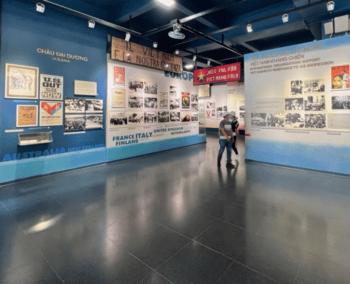There’s a saying that “the victor writes history”. Standing in the War Remnants Museum in Ho Chi Minh City, Vietnam, the question arises: Who wrote the history of the Vietnam War we were taught in Australia?
The grounds of the museum open with a collection of United States military vehicles–a UH 1 Huey Helicopter, F-5A Fighter plane, M48 Patton Tank, A-1 Skyraider Bomber and a A-37 Dragonfly Bomber–and other tools of war. Absent is any glamourisation.
For the Vietnamese people, it was the War of Resistance Against America, and the museum tells the story of what they went through to achieve victory. Before the U.S. invaded Vietnam, the French were doing their best to maintain Indochina as a colony. The people gave all they had to finally gain freedom and independence from foreign powers.
The ground floor tells the story of those around the world who wanted peace in Vietnam: Anti-war posters, images of people protesting and standing in solidarity with the Vietnamese adorn the walls. This exhibit gives off hope and shares positivity. When things got so dark and destructive for the Vietnamese, so many people were on their side, and the number of people who were anti-war kept growing.

The entrance to the museum, which houses exhibits from the international anti-war movement. (Photo: Aaron Monopoli)
On the first floor, the exhibits are confronting. The room entitled “Agent Orange Consequences in the American war of aggression in Vietnam” shows the human cost of the war for generations of Vietnamese and Americans. Agent Orange–a herbicide and defoliant chemical deployed by the U.S. military during the war to destroy forests and crops–was an agent of death and torture for the living and the unborn. Images show babies born with birth defects next to those living through Agent Orange attacks.
The next exhibit features a display of war crimes, photographed by various people. To see a modern war documented in a way that highlights its atrocities hits the heart. There is no sign of Vietnam chest beating or gloating over its victory. The war crimes exhibition shares the loss, grief, pain and suffering the Vietnamese population went through to gain their liberation.
Another room contains the story of the weapons used in the war and their consequences. A pilot drops a bomb and flies away, while a person becomes another unrecognisable body.
The reality of the war entered people’s lives outside of Vietnam through images. The stories that those with guns couldn’t tell were told by photographers and filmmakers. Shocking images of the war flowed out of Vietnam and entered the international media, helping the peace movement to grow. Eventually, the war became untenable for the U.S. and its allies to continue.
Outside the building are examples of the “tiger cages” created for Vietnamese prisoners of war. There was barely enough room to move, prisoners were left out in the weather, and treated in inhumane ways by the invaders.
The War Remnants Museum contains immense horrors captured in images, but also tells the story of the people who risked their lives to share the experiences of an oppressed people fighting for their liberation. It also tells the story of people’s solidarity around the world against a powerful nation using war to control a people.

